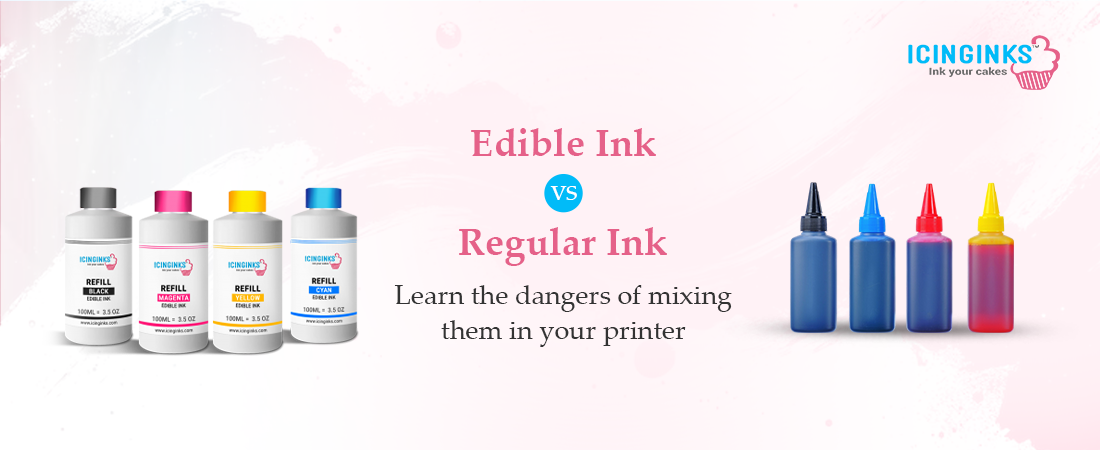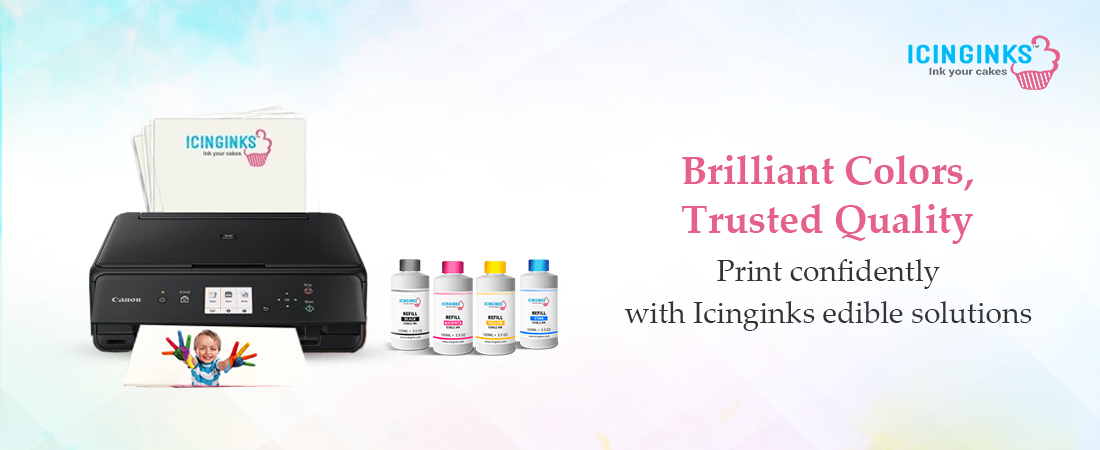
When diving into the colorful world of custom cakes, cookies, and confections, one of the most exciting innovations for decorators is the edible printer. These specialized machines allow users to print high-resolution images directly onto frosting sheets, wafer paper, and similar edible media. To do this safely, they require a specific type of ink. Edible ink is formulated with food-grade ingredients that are safe for consumption. A common mistake people make is confusing it with regular printer ink, which is not meant for food use. This confusion can lead to health risks and damage to your printing equipment.
In this blog, we’ll explore the crucial differences between the two, why they should never be mixed, and how using the correct ink helps maintain food safety, print quality, and device performance.
What Is Edible Ink?
Safe for Consumption and Designed for Food
Edible ink is a specially formulated food-grade ink made from food coloring and other edible ingredients. It's designed to be safely consumed and is typically used in conjunction with edible printers to create designs on cakes, cookies, cupcakes, and even chocolates. The ingredients are approved by food safety authorities, ensuring they are safe for human consumption.
Edible ink cartridges are produced in sterile environments and filled with consumable colorants, much like the ones used in icing or food decoration. They are specifically crafted to work with compatible edible printers and printable media such as frosting sheets or wafer paper.
How Regular Ink Works
Not Meant for Human Consumption
Regular printer ink, also known as standard inkjet or laser ink, is made for printing on paper and other non-edible materials. It contains chemicals, solvents, and pigments that are not food-safe. Ingesting even small amounts of regular ink can pose health risks, especially for children or individuals with sensitivities.
Regular ink is designed for documents, photos, and office tasks but not for items that come into contact with food. It often contains volatile organic compounds, dyes, and preservatives that could be toxic if consumed.
Key Differences Between Edible Ink and Regular Ink
Risks of Mixing Edible and Regular Ink
1. Cross-Contamination and Health Hazards
Using regular ink in a printer meant for edible printing can contaminate the entire system. Even if you switch to edible ink later, traces of chemical residue may remain in the print head or internal components. This poses a significant health risk, as the printed edible sheets may carry non-edible contaminants.
2. Permanent Printer Contamination
Printers used for regular ink cannot simply be “cleaned” and repurposed for edible ink. The microscopic particles and chemical traces left behind are difficult to remove fully. Once a printer has been used with regular ink, it is no longer suitable for use with food-safe inks.
3. Compromised Print Quality
Edible ink is more delicate and sensitive compared to regular ink. If the printer has residual chemicals from regular cartridges, it can damage the edible ink cartridge or result in streaky, discolored prints. This not only ruins the design but may also make it unsafe to consume.
Can You Use an Edible Ink Cartridge in a Regular Printer?
No, and Here’s Why
You may be tempted to try edible ink in a regular printer to save costs, but that can backfire. Regular printers are not manufactured in sterile or food-safe environments. The internal components may contain lubricants, adhesives, or past inks that are unsafe for food contact.
Even new printers straight out of the box may have chemical residue from the manufacturing process. Only edible printers certified for food use should be used with edible ink cartridges to maintain hygiene and safety standards.
Tips for Using Edible Ink Safely
1. Dedicate a Printer Only for Edible Use
Always purchase a printer designed specifically for edible printing or dedicate a new inkjet printer for edible use only. Never switch between regular and edible ink in the same device.
2. Use Approved Edible Ink Cartridges
Choose trusted brands that list their ingredients and follow guidelines set by the FDA or other food authorities. High-quality edible ink not only ensures safety but also provides better color output and print consistency.
3. Store Cartridges Properly
Like any food-grade product, edible ink has a shelf life. Store the cartridges in a cool, dry place and avoid exposing them to direct sunlight or heat. Always check expiry dates before using.
How to Clean Your Edible Printer the Right Way
Regular maintenance is essential to keep your edible printer functioning smoothly. Here’s a quick guide:
- Run a nozzle check before printing to ensure smooth ink flow.
- Use food-safe cleaning solutions designed for edible ink printers.
- Avoid alcohol-based cleaners as they can contaminate the system.
- Follow the manufacturer’s guidelines for cartridge replacement and cleaning frequency.
Cleaning your printer properly not only ensures safety but also extends its lifespan and keeps your edible ink prints looking sharp and vibrant.
Why Choose Edible Ink Over Regular Ink?
Edible ink enables you to personalize desserts for birthdays, weddings, business events, and other special occasions. It opens the door to creativity without compromising safety. Whether you’re printing family photos on a cake or branding corporate cookies, edible printers paired with high-quality edible ink make it possible.
Unlike regular ink, edible ink supports both aesthetic appeal and food-grade standards. The colors may be slightly less vibrant than traditional inks, but they’re safe, reliable, and tailored for use in culinary creations.
Conclusion
Using edible ink is not just about vibrant, eye-catching designs. It’s about safety, responsibility, and the integrity of your creations. Mixing edible ink and regular ink, even by mistake, can lead to health hazards, ruined equipment, and costly errors. Always use a dedicated edible printer and purchase ink only from reputable sources that prioritize food safety and quality.
In the world of edible printing, safety comes first. Choose edible ink wisely and handle it with the same care you would any other ingredient in your kitchen.
Why Icinginks Is the Trusted Choice for Safe, Vivid Edible Printing

When it comes to edible printing, quality and safety are non-negotiable. Icinginks offers premium edible ink made from FDA-compliant, food-grade ingredients that deliver vibrant and detailed prints on frosting sheets, wafer paper, and more. Each refill is produced in a hygienic environment, ensuring your creations are not only stunning but safe to consume.
Pair our inks with a high-performance edible printer from Icinginks, designed exclusively for cake artists, bakeries, and dessert businesses. These printers are easy to set up, compatible with top brands, and come bundled with everything you need to start printing right away.
Buy Now. Pay Later.
Pay in 4 by selecting Sezzle at checkout.
Enjoy flexible payment plans that fit your budget because your creativity shouldn't have to wait.
Ready to take your dessert decorating to the next level?
Shop our full range of edible inks and printers at Icinginks today.
FAQs
1. Can I use regular ink in an edible printer?
No, you should never use regular ink in an edible printer. Regular ink contains non-food-safe chemicals that can contaminate your printer and make edible prints unsafe for consumption. Once regular ink is used, the printer is no longer suitable for food-related purposes.
2. Is edible ink safe to consume?
Yes, edible ink is made from food-grade ingredients approved by food safety authorities, such as the U.S. Food and Drug Administration (FDA). It’s specifically formulated for use on consumable media such as frosting sheets and wafer paper, making it safe for cakes, cookies, and other decorated treats.
3. Can I convert a regular printer into an edible printer?
Technically, a new, unused inkjet printer can be dedicated to edible printing, but once regular ink has been used, it’s not safe for conversion. Chemical residues from regular ink can linger and contaminate your edible ink, posing serious health risks.
4. How long does edible ink last?
Unopened edible ink typically has a shelf life of 6 to 12 months, depending on storage conditions and brand. Once opened, it’s best to use the ink within 3 to 6 months for optimal print quality and safety. Always check expiry dates.
5. What surfaces can I print on with edible ink?
Edible ink is commonly used on frosting sheets, wafer paper, rice paper, and chocolate transfer sheets. These surfaces are specially designed to absorb edible ink while remaining safe for consumption. Regular paper should never be used for edible printing.
Similar Post:
Selecting the Right Edible Ink for Your Cake Decorating
5 Decoration Tips with Edible Ink for Baking Professionals
5 Innovative Ways To Use Edible Ink
Edible Ink Safety: What You Need to Know Before Decorating




